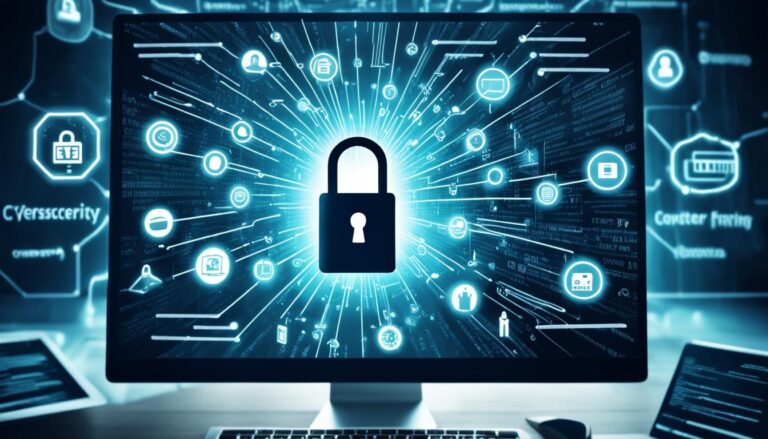
In 2023, the cybersecurity landscape saw unexpected twists and turns, with topics such as Generative Artificial Intelligence (GenAI) and ransomware making headlines. As organizations plan their security strategies for 2024, experts predict that deception tactics, the use of GenAI for customer acquisition, the rise of “doppelgänger users,” AI-driven cyberattacks, and the evolving nature of ransomware will be key trends to watch out for. Additionally, the importance of data security, consolidation of security investments, the expansion of IoT devices, and the vulnerability of small and mid-sized businesses will shape the small business security threat landscape in 2024.
Key Takeaways:
- Deception tactics, including AI-engineered deception, deep fakes, and AI-crafted phishing emails, will be prevalent in 2024.
- GenAI technology will facilitate cyber criminals in customer acquisition and monetization of data.
- The emergence of “doppelgänger users” will pose a rising threat, requiring increased security measures and password hygiene.
- AI-driven cyberattacks, reminiscent of the infamous Morris Worm, will become more common.
- Ransomware may shift its focus to consumer or small business targets.
As a cybersecurity journalist with years of experience, I have closely followed the evolving landscape of small business security threats. With a focus on providing actionable insights to protect small businesses, I understand the importance of staying informed about emerging security trends. By highlighting key trends and taking proactive measures, small businesses can enhance their cybersecurity posture and mitigate potential risks.
Deception Tactics: The Year of Deception
According to Charles Henderson, the Global Head of IBM X-Force, 2024 is poised to become the year of deception in cybersecurity. With ongoing geopolitical tensions, major elections, and high-profile events like the Paris Olympics, cyber criminals are primed to deploy advanced deception tactics engineered by AI, blurring the lines between truth and fiction. Unbeknownst to unsuspecting users, consumers, and public officials, these deceptive methods will be employed to advance malicious objectives.
One such tactic gaining notoriety is the use of deep fakes, which leverage AI algorithms to create realistic and deceptive video content. These AI-generated videos manipulate facial expressions and voices, making it increasingly challenging to discern what is real and what is fabricated. Similarly, audio fakes powered by AI algorithms can reproduce convincing voices that can be used to impersonate individuals and deceive victims.
Furthermore, cyber criminals are employing AI to craft sophisticated phishing emails that are virtually indistinguishable from legitimate communications. With machine learning capabilities, these AI-crafted phishing emails can cleverly mimic the writing style and tone of official correspondence, increasing the likelihood of successful attacks.
Deep Fakes: A Threat to Trust
The advancements in deep fake technology have elevated the level of deception in cyberspace. Deep fakes can be employed not only for identity theft and fraud but also to manipulate public opinion, create fake news, and even threaten national security. As these AI-engineered deep fakes become more refined, their potential to deceive unsuspecting individuals and society at large escalates.
AI-Crafted Phishing Emails: Conning with Precision
Phishing emails have long been a common tactic used by cyber criminals to trick individuals into revealing sensitive information or downloading malicious content. With the integration of AI, the sophistication of phishing attacks has reached a new level. AI algorithms analyze vast amounts of data, enabling attackers to personalize phishing emails, tailoring them to specific recipients and increasing the chances of success. These AI-crafted phishing emails are designed to bypass traditional email security filters and exploit human vulnerabilities.
As organizations step into the realm of AI-driven deception tactics, it becomes imperative to implement robust cybersecurity measures to counter these threats effectively. The battle against AI-engineered deception requires a combination of cutting-edge technology, user awareness, and proactive security strategies.
GenAI: Opening Doors for Cyber Criminals
Charles Henderson, an industry expert, predicts that GenAI will revolutionize customer acquisition for cyber criminals. By leveraging GenAI technology, cyber criminals can filter, correlate, and categorize vast amounts of data to create detailed profiles of potential targets. This enables them to effectively monetize the data they have collected, similar to how marketing utilizes AI for optimizing customer acquisition processes.
GenAI’s ability to extract valuable insights from extensive datasets allows cyber criminals to identify and exploit vulnerabilities within target demographics. By utilizing sophisticated algorithms, they can tailor their attacks, improving the success rate of their malicious activities. The availability of GenAI equips cyber criminals with a powerful tool to streamline their operations and increase the efficiency of their fraudulent endeavors.
Monetization of Data
A key aspect of GenAI’s impact on cybercrime is the monetization of data. With the ability to sift through immense amounts of information, cyber criminals can uncover personal, financial, and sensitive data that can be sold or exploited for financial gain. This monetization strategy mirrors the tactics employed by marketing teams to optimize customer acquisition.
The vast amount of data collected over the years by cyber criminals has immense value in underground markets. This includes personal information, login credentials, financial data, and other sensitive details that can be sold to other malicious actors or used for perpetrating identity theft, fraud, or other forms of cybercrime.
In the underground economy, cybercriminals can lucratively monetize the stolen data, creating a profitable business model that further incentivizes their illicit activities. The ease with which GenAI technology enables cyber criminals to sift through and categorize data accelerates the process of identifying valuable information, ultimately facilitating its monetization.
Implications for Cybersecurity
The advent of GenAI brings forth new challenges for cybersecurity professionals aiming to combat cybercrime. It calls for robust defense mechanisms and strategies that can effectively detect and counteract the evolving tactics employed by cyber criminals.
Implementing proactive security measures is crucial to mitigate the risks associated with GenAI-enabled cybercrime. Organizations must continuously update their security systems, invest in cutting-edge technologies, and leverage advanced threat intelligence to stay one step ahead of the malicious actors. Furthermore, fostering a culture of data protection and cybersecurity awareness among employees is essential to fortify the overall security posture.
As the battle between cybersecurity professionals and cybercriminals continues to escalate, the responsible adoption of emerging technologies like GenAI can play a pivotal role in addressing these threats. By harnessing the power of AI and data analytics for defensive purposes, organizations can effectively identify vulnerabilities, respond promptly to emerging threats, and safeguard sensitive data from falling into the wrong hands.
| GenAI in Cybercrime | Implications |
|---|---|
| Enables cyber criminals to filter, correlate, and categorize data | Accelerates the identification of potential targets |
| Facilitates the monetization of collected data | Increases financial incentives for cybercriminals |
| Challenges cybersecurity professionals to adapt and implement proactive defense strategies | Highlights the importance of continuous updates and advanced threat intelligence |
| Prompts responsible adoption of emerging technologies for defensive purposes | Offers a potential solution to combat evolving cyber threats |
Doppelgänger Users: A Rising Threat
As Chief Architect of IBM X-Force, Dustin Heywood suggests that small businesses are expected to face a growing threat from “doppelgänger users” in 2024. These adversaries are skilled at assuming the digital identities of legitimate users and exhibiting varying behaviors on different days. This erratic conduct should raise alarm bells for enterprises as it indicates a compromise in security. Furthermore, with millions of authentic enterprise credentials readily available on the Dark Web, attackers are exploiting stolen identities to gain unauthorized access to overprivileged accounts. Heightened vigilance regarding security measures and robust password hygiene measures are critical to combating this increasing threat.
The Rise of Doppelgänger Users
The infiltration of doppelgänger users poses a significant challenge for small businesses in 2024. These malicious actors skillfully mimic the digital profiles of legitimate users, making it difficult to detect their fraudulent activities. Their ability to seamlessly assume false identities enables attackers to gain unauthorized access to sensitive information, compromising the confidentiality, integrity, and availability of critical business data.
One of the alarming aspects of doppelgänger users is their unpredictable behavior. They intentionally exhibit different patterns of activity on different days, mimicking the legitimate user’s behavior to evade suspicion. This abnormal activity is a telltale sign of compromise, alerting organizations to potential security breaches and identity theft. Detecting these anomalies and promptly investigating suspicious behavioral patterns are crucial steps in identifying and mitigating the risk posed by doppelgänger users.
Impact of Compromised Credentials
Compromised credentials present a significant threat to businesses of all sizes. With millions of genuine enterprise credentials available on underground marketplaces, attackers can exploit stolen identities to gain unauthorized access to corporate systems and accounts. Once inside, these adversaries can wreak havoc by exfiltrating sensitive data, launching further attacks within the network, or compromising the integrity of business operations.
Organizations must prioritize robust security measures, such as multifactor authentication (MFA) and continuous monitoring, to mitigate the risk of compromised credentials. Additionally, fostering a culture of cybersecurity awareness among employees and implementing regular training programs on password hygiene and best security practices can help safeguard against this growing threat.
| Impact of Doppelgänger Users | Prevention Measures |
|---|---|
| Unauthorized access to sensitive information | Implement strong authentication protocols and multifactor authentication (MFA). |
| Data breaches and loss of confidentiality | Regularly monitor and analyze user behavior for suspicious activity. |
| Compromise of critical business operations | Conduct regular cybersecurity training to educate employees on identifying and reporting suspicious behavior. |
| Erosion of customer trust and loyalty | Equip employees with robust password management practices and encourage regular password updates. |

Staying one step ahead of doppelgänger users requires a proactive approach to cybersecurity. By implementing stringent security measures, conducting regular risk assessments, and educating employees on identifying and responding to potential threats, small businesses can fortify their defenses against the rising tide of identity theft and compromised credentials.
AI-Driven Cyberattacks: The Morris Worm of the Future
John Dwyer, the Head of Research at IBM X-Force, envisions a future where AI-driven cyberattacks akin to the notorious Morris Worm become a reality. Although widespread implementation of AI-engineered cyberattacks may still be some time away, the growing availability of AI platforms is expected to lead adversaries to exploit the nascent AI attack surface, resulting in a surge of AI-scaled malicious campaigns.
If we take a look back at the Morris Worm, a self-replicating computer program that wreaked havoc on the early internet in 1988, its impact was profound and far-reaching. Robert Tappan Morris, the creator of the worm, unintentionally revealed the vulnerabilities and potential risks associated with interconnected systems. The ripple effect from the Morris Worm lingers even to this day as a cautionary tale.
Now, with the advent of AI and its integration into various domains, the potential for AI-driven cyberattacks to dwarf the impact of the Morris Worm is a real concern. Adversaries armed with AI tools and platforms can automate and orchestrate attacks at an unprecedented scale, making them more efficient, adaptable, and evasive.
The wide adoption of AI creates a new attack surface that hackers and cybercriminals can exploit to their advantage. Advances in machine learning and deep learning algorithms enable AI to learn and adapt to changing circumstances, making it harder to detect and mitigate attacks. Adversaries can leverage AI to identify vulnerabilities, evade security controls, and launch highly sophisticated and targeted attacks.
As AI technology continues to evolve, organizations must remain vigilant in fortifying their defenses against AI-driven cyberattacks. By investing in AI-powered security solutions, businesses can leverage the same technology that adversaries may try to use against them, staying one step ahead in the cybersecurity arms race.
In the face of this emerging threat landscape, collaboration and information sharing among industry experts, researchers, and organizations become crucial. By collectively studying and analyzing AI-driven cyberattacks, we can develop proactive strategies and defenses to safeguard our digital ecosystem.
The future may hold the next Morris Worm-like cyberattack, propelled by the power of AI. It is imperative that we stay prepared, equipped with advanced technologies, and armed with collaborative insights to defend against the evolving threat landscape.
Only time will tell how the saga of AI-driven cyberattacks unfolds. In the meantime, organizations must prioritize cybersecurity measures, implement robust defenses, and continuously evolve their security strategies to mitigate the risks posed by AI-powered adversaries.
Ransomware: Facing a Recession and a Makeover
As the cybersecurity landscape evolves, ransomware is poised to undergo significant changes in 2024. According to John Dwyer, an industry expert, more countries are pledging not to pay ransoms, and fewer enterprises are succumbing to the pressure of encrypted systems. This shift in the ransomware landscape could result in a recession for this malicious malware.
Ransomware operators, however, are not backing down. Instead, they are refocusing their efforts on new targets, such as consumers and small businesses. These targets prove to be lucrative for cybercriminals, as the leverage and likelihood of paying ransoms remain high. Small businesses, in particular, are especially vulnerable to high-pressure data extortion due to their limited resources and cybersecurity measures.
This shift in targeting strategy will also prompt ransomware to undergo a makeover. As the threat landscape becomes more challenging for attackers, they will adapt their tactics and techniques to maximize their impact. Ransomware attacks will likely become more sophisticated, employing advanced encryption methods and leveraging social engineering techniques to bypass defenses.
Impact on Small Business Targets
Small businesses have become prime targets for ransomware attacks due to their perceived vulnerabilities. Limited budgets, lack of dedicated IT teams, and insufficient cybersecurity measures make them easy prey for cybercriminals. With the potential for significant financial losses, reputational damage, and the potential compromise of customer data, the impact on small businesses can be devastating.
The image below illustrates the increasing targeting of small businesses by ransomware:
| Impact on Small Businesses | |
|---|---|
| Financial Losses | Small businesses may face significant financial losses due to ransom payments, downtime, and recovery costs. |
| Reputational Damage | A successful ransomware attack can tarnish the reputation of small businesses, leading to customer distrust and potential loss of business. |
| Data Breaches | Ransomware attacks can result in the compromise of sensitive customer data, leading to legal and compliance issues. |
| Operational Disruption | Ransomware can paralyze small business operations, causing significant disruptions and delays in service delivery. |
To protect themselves from ransomware attacks, small businesses need to prioritize their cybersecurity efforts. This includes implementing robust backup and recovery solutions, regularly updating software and security patches, providing employee training on phishing and social engineering, and investing in advanced threat detection and response capabilities.
While ransomware is expected to undergo changes in 2024, it remains a significant threat to small businesses. By understanding the evolving tactics and taking proactive security measures, small businesses can minimize their risk and better defend against ransomware attacks.
GenAI and Critical Data: A Focus for CISOs
As artificial intelligence becomes increasingly integrated into enterprise infrastructure, Chief Information Security Officers (CISOs) face the challenge of ensuring the security of critical data. The centralization of various types of data into AI models introduces new risks that require careful consideration and proactive measures.
One key aspect that CISOs must address when it comes to GenAI is stakeholder access. With the utilization of AI models, multiple stakeholders may need to access the same centralized data. CISOs must establish robust access controls and authentication mechanisms to safeguard the critical data from unauthorized access.
An additional concern for CISOs is the inference and live use of the AI models. As these models process and make decisions based on the critical data, it is essential to protect them from adversarial attacks or malicious manipulation. Implementing strict security measures, such as secure model deployment and runtime monitoring, can help mitigate these risks.
Redefining Critical Data and Access Controls
With the integration of GenAI, CISOs must redefine what data is considered critical to their organizations. Critical data encompasses sensitive information, trade secrets, intellectual property, customer data, and any other data that, if compromised, could pose an existential threat to the organization.
Once the critical data is identified, CISOs should reassess the security and access controls surrounding it. This includes implementing multi-factor authentication, strong encryption algorithms, and robust data loss prevention mechanisms to ensure the confidentiality, integrity, and availability of data throughout its lifecycle.
| Data Security Measures | Description |
|---|---|
| Data Classification | Identify and categorize data based on sensitivity to apply appropriate security controls. |
| Encryption | Utilize strong encryption algorithms to protect data at rest and in transit. |
| Access Controls | Implement strict access controls to ensure only authorized individuals can access critical data. |
| Data Loss Prevention (DLP) | Deploy DLP solutions to monitor and prevent the unauthorized transmission of sensitive data. |
| Security Audits | Regularly conduct security audits to identify vulnerabilities and ensure compliance with security policies. |
By focusing on the security of critical data, CISOs can help mitigate the risks associated with GenAI integration and protect their organizations from potential threats.
Empowering Security Analysts with GenAI
As Chris Meenan, Vice President of Product Management at IBM Security, suggests, GenAI offers significant potential in enhancing the capabilities of security analysts. By integrating artificial intelligence into the security landscape, GenAI can revolutionize how security teams operate, allowing them to focus on more critical tasks and provide proactive threat protection.
One of the key advantages of GenAI lies in its ability to automate tedious administrative tasks that consume a significant amount of time for security analysts. By leveraging AI-powered automation, GenAI can streamline routine processes such as log monitoring, incident ticketing, and vulnerability assessments. This frees up valuable time for security analysts to concentrate on more complex tasks that require human expertise.
Furthermore, GenAI can bridge the gap between experienced and less experienced security analysts. It can provide valuable support to junior team members by offering insights, recommendations, and real-time guidance based on its advanced analytics capabilities. This empowers less experienced analysts to handle more complex security issues, allowing for efficient knowledge transfer and skills development within the team.
One significant contribution made by GenAI is its ability to transform technical content into simplified language. This is especially valuable when communicating complex security information to stakeholders who may not possess a deep understanding of cybersecurity. GenAI can generate clear and concise reports, summaries, and visualizations, making it easier for analysts to convey critical insights to decision-makers.
Overall, the integration of GenAI in the security landscape brings substantial benefits to security analysts. By automating tedious tasks, enabling less experienced team members, and simplifying technical information, GenAI maximizes the human element in security operations. Security analysts can focus on more challenging and strategic work, enhancing their effectiveness in identifying, mitigating, and preventing cybersecurity threats.
| Benefits of Empowering Security Analysts with GenAI |
|---|
| Automates tedious administrative tasks |
| Enables less experienced team members to handle complex tasks |
| Transforms technical content into simplified language |
| Enhances effectiveness in identifying and mitigating threats |
From Threat Prevention to Prediction: The Future of Cybersecurity
The future of cybersecurity lies in threat prediction at scale, according to Sridhar Muppidi, CTO of IBM Security. As AI technologies continue to mature, there will be a shift from reactive threat detection and response to proactive prediction and protection. AI will play a critical role in transforming the cybersecurity industry and achieving prediction at scale.
In the past, the cybersecurity industry has primarily focused on threat prevention, implementing measures to protect networks, systems, and data from potential attacks. While threat prevention remains vital, the evolving threat landscape requires a more proactive approach.
AI, with its ability to analyze vast amounts of data and identify patterns and anomalies, holds tremendous potential for predicting cyber threats before they occur. By leveraging AI algorithms and machine learning models, cybersecurity professionals can stay one step ahead of attackers, anticipating their tactics and developing effective defense strategies.
The advantages of threat prediction go beyond simply preparing for known threats. AI-powered systems can detect subtle indicators and warning signs, even in emerging threats that have not yet been discovered. This predictive capability enables organizations to preemptively address vulnerabilities and implement targeted security measures.
Threat prediction at scale requires the integration of AI into all stages of the cybersecurity lifecycle, from risk assessment and vulnerability scanning to incident response and threat intelligence. By harnessing the power of AI, cybersecurity professionals can automate labor-intensive tasks, enhance analysis and decision-making processes, and optimize resource allocation.
To illustrate the importance of threat prediction, below is a table showcasing the key differences between threat prevention and prediction in the cybersecurity industry:
| Threat Prevention | Threat Prediction |
|---|---|
| Focused on preventing known threats | Proactively identifies and predicts emerging threats |
| Reactive approach to incident response | Preemptive measures to mitigate risks before they materialize |
| Relies on rule-based systems and signatures | Leverages AI algorithms and machine learning models |
| Primarily manual processes | Automated analysis and decision-making |
As the cybersecurity industry continues to evolve, organizations must prioritize threat prediction to stay resilient against the ever-growing sophistication of cyber threats. By embracing AI technologies and integrating them into their security strategies, they can achieve a proactive cybersecurity posture, safeguarding their critical assets and data from emerging threats.
Identity Fabric: A New Approach to Security’s “Identity Crisis”
Wes Gyure, Director of Identity and Access Management at IBM Security, suggests that organizations should embrace an “identity fabric” approach. This innovative approach focuses on integrating and enhancing existing identity solutions rather than replacing them completely. By doing so, businesses can create a more streamlined and less complex environment with consistent security authentication flows and enhanced visibility.
Implementing an identity fabric allows organizations to leverage their current investments in identity solutions while addressing the challenges posed by the increasingly complex security landscape. Instead of dealing with multiple disjointed systems, organizations can bring together different identity solutions into a unified fabric, enabling more efficient management of user identities and access rights. This holistic approach ensures that security measures are applied consistently across various systems and applications, enhancing overall protection against unauthorized access and cyber threats.
In an identity fabric, identity solutions are seamlessly integrated, providing a cohesive and comprehensive view of user identities across the organization. This integration enables organizations to enforce consistent security policies and authentication methods, reducing the risk of identity-related vulnerabilities. By centralizing identity management, organizations can achieve better visibility and control over user access, making it easier to detect and mitigate potential security risks.
Moreover, an identity fabric fosters interoperability between different identity solutions, allowing organizations to leverage the strengths of each solution while overcoming their limitations. This interoperability enhances the user experience by providing a seamless and frictionless authentication process across various systems and applications. It also facilitates the adoption of emerging authentication technologies, such as biometrics or multi-factor authentication, to strengthen security without disrupting existing workflows.
Adopting an identity fabric approach offers several benefits to organizations, including:
- Streamlined user provisioning and deprovisioning processes
- Enhanced visibility and control over user access rights
- Consistent enforcement of security policies
- Efficient management of authentication methods
- Improved user experience through seamless authentication
By embracing the concept of identity fabric, organizations can effectively address the “identity crisis” in security and create a robust foundation for protecting their digital assets and sensitive data.

Quantum Advancements and the Need for Quantum-Safe Cryptography
As quantum computing continues to advance at a rapid pace, organizations must confront the potential vulnerabilities it poses to their data security. Ray Harishankar, an IBM Fellow, sounds the alarm, warning of the increasing prevalence of “harvest now, decrypt later” attacks. Quantum computers have the capability to break widely used security protocols, leaving current classical systems vulnerable to cyber threats.
To safeguard against these quantum threats, organizations need to start preparing for the transition to quantum-safe cryptography. This involves identifying the cryptography used in their environments and taking steps to ensure the security of their data and systems. Quantum-safe cryptography offers protection against attacks by quantum computers, ensuring that sensitive information remains secure.
Recognizing the urgency of this issue, the U.S. National Institute of Standards and Technology (NIST) is actively developing new quantum-safe cryptography standards. These standards will provide organizations with the guidelines and best practices necessary to address the challenges posed by quantum advancements and implement robust security measures.
In the face of quantum advancements, organizations cannot afford to wait. By embracing quantum-safe cryptography and staying ahead of potential threats, they can ensure the integrity and confidentiality of their data, reinforcing their overall cybersecurity posture for the future.






